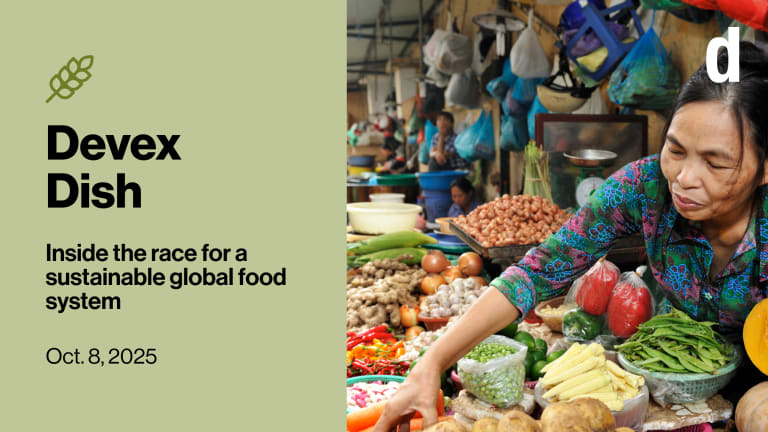
In the effort to reshape food systems for a changing climate, one key area is often overlooked: The “hidden middle” of the value chain. While much of the conversation focuses on either agriculture or consumption, the middle segments of the global food value chain — such as processing, packaging, and distribution — have stayed out of the spotlight. Once an underappreciated part of food systems, the hidden middle is increasingly recognized as a crucial leverage point in our ability to safely feed a growing population in a fast-warming world. It is also a vital source of the jobs and income needed to fuel just transitions to low-emissions, climate-resilient economies worldwide.
At the COP29 U.N. climate summit in Baku, Azerbaijan, in November, Tetra Pak, the U.N. Industrial Development Organization, and the Global Alliance for Improved Nutrition co-hosted two roundtable events with global food systems leaders and policymakers to explore how strengthening these often-neglected segments can promote both food security and climate resilience.
Here are five main takeaways from the discussions:
1. Communicating to make the invisible visible
Despite representing up to 40% of the economic value-added in food systems and untold millions of jobs around the world, the hidden middle has long been underrepresented in global financial and policy discussions. This oversight must be addressed if we aim to confront the interrelated challenges of climate change and food security, event participants stressed.
If adequately resourced and managed, efficient food manufacturing infrastructure can meaningfully help to buffer against climate-related disasters and shocks and reduce food loss, while ensuring stable employment and economic growth, consistent food security, and availability.
“Likewise, the hidden middle provides an essential source of employment in developing countries — often held by women and youth”, explains Dr. Rebecca Carter, director of climate adaptation and resilience at the World Resources Institute. “Jobs in food processing, storage, and distribution form an essential source of employment, particularly in developing countries that depend heavily on agricultural exports,” said Carter, highlighting how, like farmers, these workers are increasingly vulnerable to climate change, making it essential to build more resilient value chains.
This added complexity highlights why climate change can no longer be viewed solely as an environmental challenge, but as a critical systemic issue that directly affects global food security and supply chain resilience.
Roundtable participants agreed storytelling can be a powerful tool in helping policymakers and the public grasp this crucial interplay. Translating supply chain dynamics into relatable human-centric narratives has the potential to illuminate the hidden middle’s great value and unseen vulnerability.

2. Scaling up smart solutions
In moving from recognition to action, there are many immediate pathways to enhance food system resilience. Proven solutions such as solar-powered cold storage facilities, advanced aseptic technology, and packaging solutions stand ready to transform how food is preserved and distributed globally. The challenge therefore lies not in developing new technologies but in scaling existing ones.
What is aseptic technology?
Aseptic processing is a technique wherein commercially thermally sterilized liquid food products are packaged into previously sterilized containers under sterile conditions to produce shelf-stable products that do not need refrigeration. This allows food to be safely stored at room temperature without microbial growth.
When looking to scale up solutions in rural areas, the developments exist, but many challenges remain a bottleneck. Reflecting on GAIN’s work in Nigeria’s tomato sector, Saul Morris, director of program services at GAIN, observed that many potential interventions on and off the farm had positive returns on investment, but just because they were profitable didn’t mean these technologies were scalable.
“The relevant actors don't have [the] small amount of start-up capital or are not aware of opportunities that are there. Often, there are cartels and other barriers that make it hard for people to enter markets. Investing in people and tackling governance challenges are key to unlocking these solutions,” Morris said.
It is also important to ensure that no segment of the agrifood ecosystem is overlooked. Morris observed that “food is grown and eaten in different places.” While food is grown in rural areas, more than half of consumers now live in urban areas. “Even in rural areas, farmers are buying more than half of their food from the market. All of this movement and value addition constitutes the hidden middle of the food system,” said Morris, explaining that the most nutritious food is often also the most perishable.
Micro, small, and medium-sized enterprises, or MSMEs, which constitute the backbone of food systems, also require more funding and assistance. These companies are critical players in local food networks but commonly lack the resources and capacities for technological advancement.
3. Designing fit-for-purpose finance methods
Despite growing recognition of the importance of the hidden middle, current financing commitments are failing to match the scale of capital deployment required to build climate resilience. While COP29 confirmed the critical role of the food systems transformation, a persistent funding gap remains.
Innovative financing mechanisms are especially needed for MSMEs that often struggle to access conventional funding channels. Priority should be given to streamlining access and reducing the many bureaucratic hurdles that prevent smaller players from securing the resources they urgently need, participants shared.
Ultimately, building a funding ecosystem to accelerate the adoption of resilient practices along the entire food supply chain requires that public finance and the private sector play a bigger and more coordinated role in co-designing more fit-for-purpose methods.
4. Building more inclusive partnerships
No single entity, regardless of size or influence, can drive food system change alone. As Ali Badarneh, the chief of UNIDO's food security and food systems unit, pointed out: “The escalating costs of addressing hunger and the hidden costs of current agrifood systems underscore the urgent need for immediate and decisive action.”
Recently, UNIDO and the Food and Agriculture Organization launched the report — “Ending Hunger is Possible” to urge action for governments, international organizations, the private sector, and civil society to collaborate in innovative ways to tackle the structural challenges of hunger and malnutrition. Specifically, it advocates for generating income for affected communities through local value addition in the agrifood sector, Badarneh explained, transforming raw agricultural products into higher-value goods to boost economic opportunities and food security.
Forging real cross-sector collaboration requires including more diverse perspectives from different industry domains, regions, and lived experiences. The insights of global south nations and Indigenous communities are particularly indispensable, as they bring generational wisdom about sustainable food practices and a firsthand understanding of local challenges needed to ensure solutions can be practically implemented.
By connecting local initiatives to global frameworks, food systems can become more resilient and adaptable, respecting geographical differences while meaningfully contributing to global climate and food security goals.
5. Acting today, thinking of tomorrow
The mounting effects of the climate crisis on the global food supply chain are already affecting millions and demand urgent action. As Lars Holmquist, executive vice president for sustainability at Tetra Pak, added: “No NDC 3.0 is complete without incorporating food system transformation across the entire chain — this is what we mean by unlocking the hidden middle.”
What is NDC 3.0?
Nationally determined contributions, or NDCs, represent each country’s self-determined climate targets to limit global warming to well below 2 degrees Celsius, not exceeding 1.5C, above preindustrial levels. NDC 3.0 refers to the next generation of these contributions, emphasizing enhanced ambition, transparency, and implementation strategies.
Malini Mehra, CEO at GLOBE International and roundtable moderator, emphasized the urgency of climate action as COP29 transitions to COP30. “The world needs giant strides, not small steps, in this critical year for climate action,” she said. She also highlighted how discussions at COP29 showcased the potential of the hidden middle to drive this progress. “As governments prepare their NDCs 3.0 right now, they would be wise to pay heed and integrate their lessons for more ambitious and effective food security plans.”
Yet the trajectory of this complex and rapidly evolving threat remains uncertain. This dual challenge of addressing immediate needs while planning for future unknowns requires a double-timed strategy: one that drives decisive action based on current knowledge while building the strength and flexibility needed to adapt to emerging risks.
The good news is that there's much that can be done fast. Simple yet effective measures, such as strategically relocating storage facilities, can yield immediate benefits while contributing to long-term resilience. Evidence-based solutions already exist to boost renewable energy, reduce greenhouse gas emissions, increase water conservation, and prevent food loss across the whole agri-food value chain. Now the focus must be scaling them.
Still, the path forward demands more than incremental technological improvements. It requires unlocking all the untapped potential of our food chain's hidden middle by turning each vulnerable link into a powerful lever of change.








